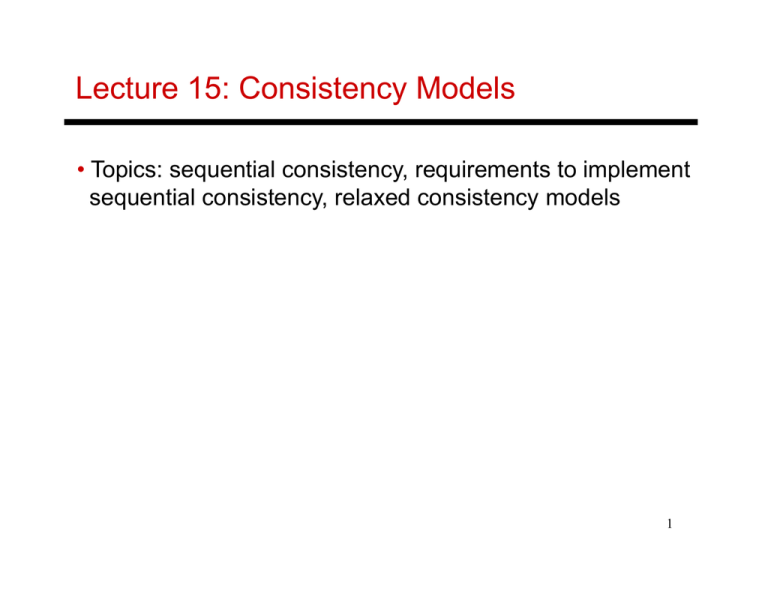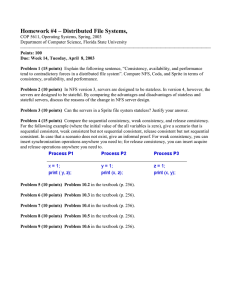Lecture 15: Consistency Models
advertisement

Lecture 15: Consistency Models
• Topics: sequential consistency, requirements to implement
sequential consistency, relaxed consistency models
1
Coherence Vs. Consistency
• Recall that coherence guarantees (i) that a write will
eventually be seen by other processors, and (ii) write
serialization (all processors see writes to the same location
in the same order)
• The consistency model defines the ordering of writes and
reads to different memory locations – the hardware
guarantees a certain consistency model and the
programmer attempts to write correct programs with
those assumptions
2
Example Programs
Initially, A = B = 0
P1
A=1
if (B == 0)
critical section
P2
B=1
if (A == 0)
critical section
P1
Data = 2000
Head = 1
P2
while (Head == 0)
{}
… = Data
Initially, A = B = 0
P1
A=1
P2
P3
if (A == 1)
B=1
if (B == 1)
register = A
3
Consistency Example - I
• Consider a multiprocessor with bus-based snooping cache
coherence and a write buffer between CPU and cache
Initially A = B = 0
P1
P2
AÅ1
BÅ1
…
…
if (B == 0)
if (A == 0)
Crit.Section
Crit.Section
The programmer expected the
above code to implement a
lock – because of write
buffering, both processors
can enter the critical section
The consistency model lets the programmer know what assumptions
4
they can make about the hardware’s reordering capabilities
Consistency Example - 2
P1
Data = 2000
Head = 1
P2
while (Head == 0) { }
… = Data
Sequential consistency requires program order
-- the write to Data has to complete before the write to Head can begin
-- the read of Head has to complete before the read of Data can begin
5
Consistency Example - 3
P1
P2
A=1
B=1
A=2
C=1
P3
while (B != 1) { }
while (C != 1) { }
register1 = A
P4
while (B != 1) { }
while (C != 1) { }
register2 = A
• register1 and register2 having different values is a
violation of sequential consistency – possible if updates
to A appear in different orders
• Cache coherence guarantees write serialization to a
single memory location
6
Consistency Example - 4
Initially, A = B = 0
P1
A=1
P2
P3
if (A == 1)
B=1
if (B == 1)
register = A
Sequential consistency can be had if a process makes sure that
everyone has seen an update before that value is read – else,
write atomicity is violated
7
Implementing Atomic Updates
• The above problem can be eliminated by not allowing a
read to proceed unless all processors have seen the last
update to that location
• Easy in an invalidate-based system: memory will not service
the request unless it has received acks from all processors
• In an update-based system: a second set of messages is
sent to all processors informing them that all acks have been
received; reads cannot be serviced until the processor gets
the second message
8
Sequential Consistency
• A multiprocessor is sequentially consistent if the result
of the execution is achieveable by maintaining program
order within a processor and interleaving accesses by
different processors in an arbitrary fashion
• The multiprocessors in the previous examples are not
sequentially consistent
• Can implement sequential consistency by requiring the
following: program order, write serialization, everyone has
seen an update before a value is read – very intuitive for
the programmer, but extremely slow
9
Performance Optimizations
• Program order is a major constraint – the following try to
get around this constraint without violating seq. consistency
¾ if a write has been stalled, prefetch the block in
exclusive state to reduce traffic when the write happens
¾ allow out-of-order reads with the facility to rollback
if the ROB detects a violation
• Get rid of sequential consistency in the common case and
employ relaxed consistency models – if one really needs
sequential consistency in key areas, insert fence
instructions between memory operations
10
Relaxed Consistency Models
• We want an intuitive programming model (such as
sequential consistency) and we want high performance
• We care about data races and re-ordering constraints for
some parts of the program and not for others – hence,
we will relax some of the constraints for sequential
consistency for most of the program, but enforce them
for specific portions of the code
• Fence instructions are special instructions that require
all previous memory accesses to complete before
proceeding (sequential consistency)
11
Potential Relaxations
• Program Order: (all refer to different memory locations)
¾ Write to Read program order
¾ Write to Write program order
¾ Read to Read and Read to Write program orders
• Write Atomicity: (refers to same memory location)
¾ Read others’ write early
• Write Atomicity and Program Order:
¾ Read own write early
12
Relaxations
Relaxation
WÆR
Order
IBM 370
X
TSO
X
PC
X
SC
W Æ W R ÆRW Rd others’ Wr
Order
Order
early
Rd own Wr
early
X
X
X
X
¾ IBM 370: a read can complete before an earlier write to a different address, but a
read cannot return the value of a write unless all processors have seen the write
¾ SPARC V8 Total Store Ordering (TSO): a read can complete before an earlier
write to a different address, but a read cannot return the value of a write by another
processor unless all processors have seen the write (it returns the value of own
write before others see it)
¾ Processor Consistency (PC): a read can complete before an earlier write (by any
processor to any memory location) has been made visible to all
13
Safety Nets
• To explicitly enforce sequential consistency, safety nets
or fence instructions can be used
• Note that read-modify-write operations can double up as
fence instructions – replacing the read or write with a
r-m-w effectively achieves sequential consistency – the
read and write of the r-m-w can have no intervening
operations and successive reads or successive writes
must be ordered in some of the memory models
14
Title
• Bullet
15





